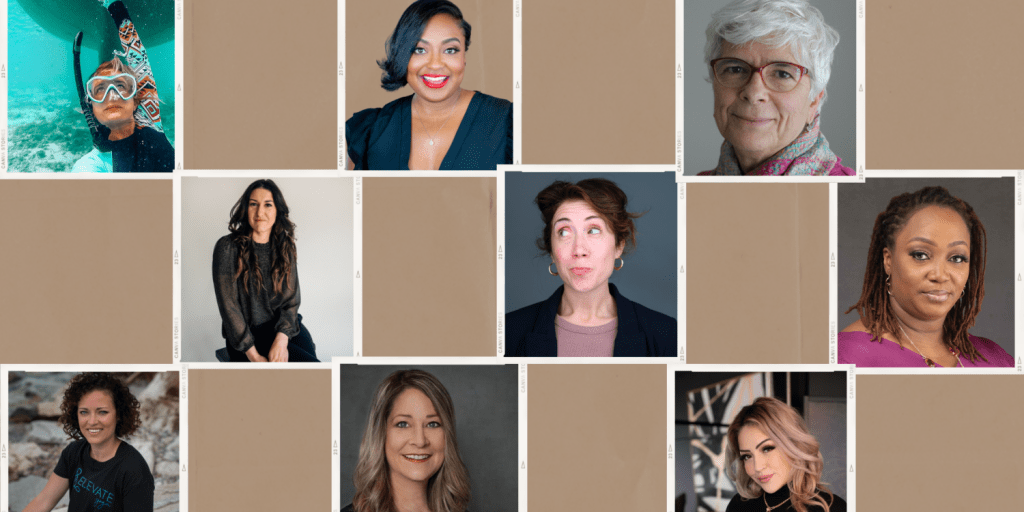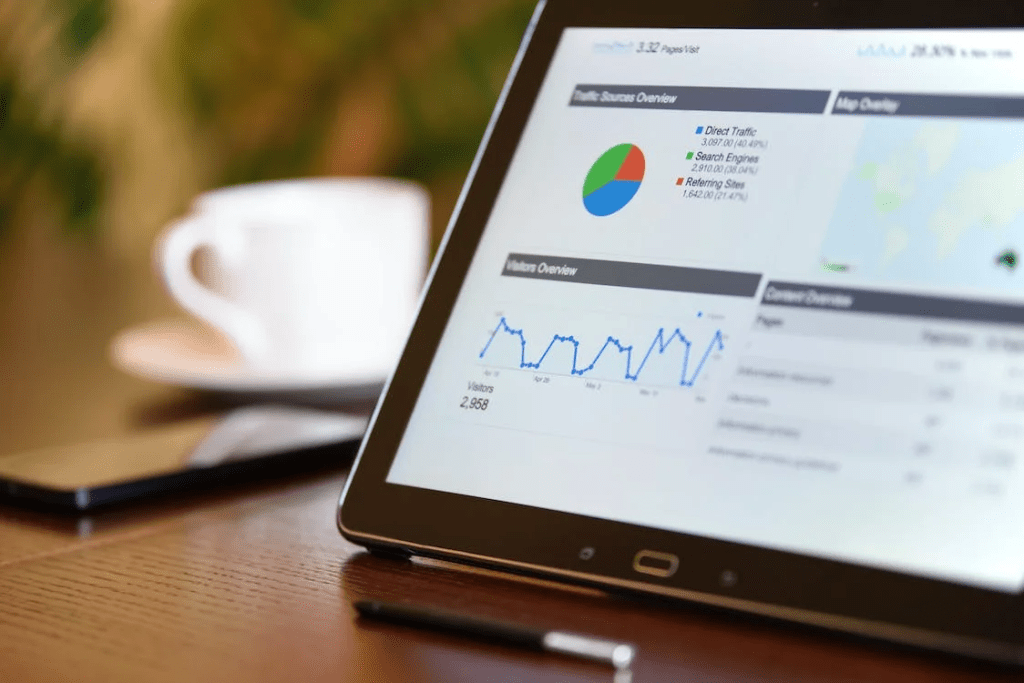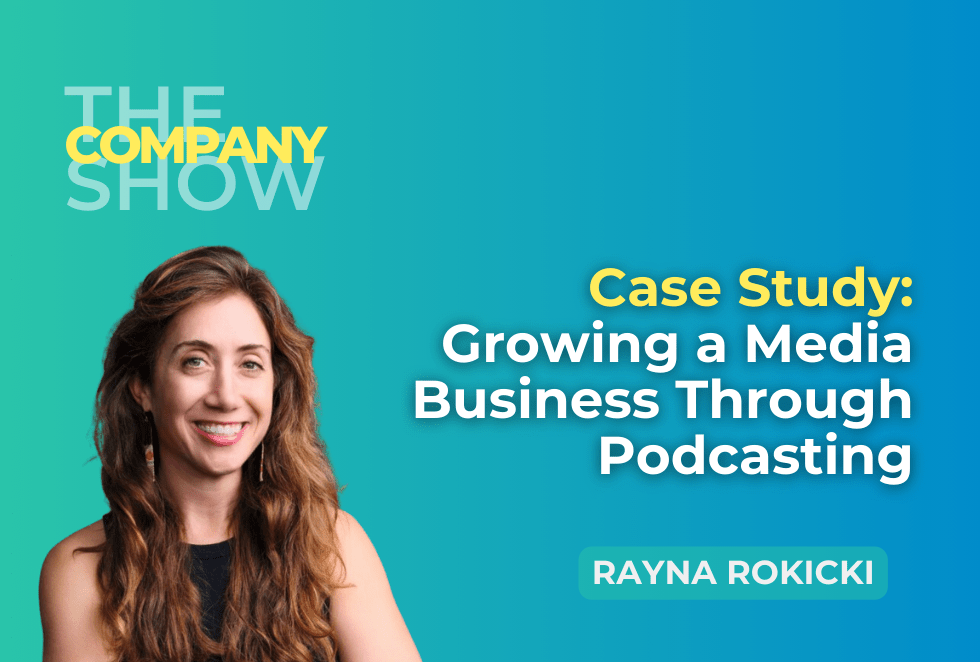On this podcast case study episode, we’re taking a look at how Rayna Rokicki, the owner of Ladies First Digital Media and the host of the You Betcha She Did! podcast, uses a relationship-building guest strategy perfectly to grow her show and her business.
Relationship-building is one of the most popular and effective podcast goals for companies. This helps them create and nurture the connections they need for different kinds of business growth, from new leads to educating and serving existing customers, to referral partners, to potential collaboration partners, and dare I say, maybe even new friends too.
This podcast case study explores how Rayna created a great show and strategically uses it to grow her media business by connecting with potential clients, refining and experimenting with formats to use within the business, and creating awareness of the many amazing women in her area, herself included.
It is a fantastic conversation and you’re really going to enjoy it. Listen to the case study episode below or continue reading the blog post!
Tune in to this podcast case study episode to learn about:
- Rayna’s team templates and workflow
- Goal setting and pivoting
- Tech tools and social media strategies
- How all of these helped Rayna achieve her long-term objectives
Don’t forget to join us for our free monthly strategy calls on the third Thursday of every month!
The Power of Guests and Genuine Relationships
Podcasts with guests are one of the most popular formats for shows in The State of Business Podcasting Report. One of the areas that we look at is whether and how guests are integrated into podcasts.
The results are very clear. 55% of the top 100 always have guests as the main body of their episode. Another 18% have guests sometimes so in some episodes, but not all. And 9% have guest segments in some or all of their episodes, as opposed to them being the main thrust of the entire episode.
Obviously, the data really supports having guests as a strategy. And when you have a good understanding of the relationship between the guests that you talk to on your podcast and the business outcomes you need, you can establish and track the metrics that tell you whether or not your guest strategy is working as planned, or if you need to pivot.
If you’re wondering how to do that, or if you should have guests on your podcast at all, then today’s podcast case study conversation is going to help you decide.
Podcast Case Study: The Story of Ladies First Digital Media and Rayna Rokicki

Rayna: “Like a lot of stories, it’s a little long-winded, so I’m going to try to give you the cliff notes version.
Originally, I was a teacher for many years of my life, and my husband and I taught overseas, and it was great. We taught in Nigeria for six years, in Myanmar for two years, and then we came back to the United States in Covid, and I was looking for a different career.
I’ve always wanted to do something that lifted women up, and helped empower women, especially moms. And I’ve always been interested in podcasts and audio. And so I decided to kind of pivot that way, not only because it would fulfill this lifelong passion of elevating women’s voices, but also because it’s just an interest I’d had for a long time.
So that’s where the idea of Ladies First Digital Media came from. As you can imagine from the name, not that I’m opposed to helping men, but I do want to primarily work with women. So, ladies first, with the idea that we are going to help women be seen and heard through podcasts and YouTube channels and out of that business, I decided one of the best ways for me to really dig into podcasting and learn more about it is to have my own podcast.
Because you can take all the classes, you obviously work on your clients’ podcasts. But I’m like, you know what? I really want to have my own podcast, which is very similar to what my whole company is about.
You Betcha She Did! Podcast
My podcast is called You Betcha She Did! So again, a little Midwest language there. Like, did she really do that? You betcha she did all about really cool, rad women, especially in the midwest of the US, doing neat things.
But I thought it’d be a great way for me to kind of push that whole idea, that whole passion I have, but also use it kind of like as an experimental place where I can try different ideas with my own podcast and see how they leverage, see how they work before I want to apply them to my clients’ podcasts.
It’s mostly women entrepreneurs, generally women either in the coaching or education space, doing something to help families or other women in their lives. And right now my clients are from kind of all over the US.
Rayna’s Endgame
Really my dream, I’m going to whisper it out there, is to develop a more Midwest-based podcast production company. I’d love to have more women in the Midwest area kind of form a network because for a while I used to work for a podcast production company in North Carolina, Nava Studios.
They’re awesome. And almost all their podcasters are from the North Carolina region, especially from Charlotte. And I just thought that was so cool. They’re all women. They’ve got great shows. And I kept thinking, why do we not have this in Wisconsin? Why do we not have this in Michigan and Illinois? So that’s my end game.
I’d love to kind of be a Midwest podcast production company, but in the meantime, I love the clients I currently have. I love all their missions because everyone’s mission that I work with, I was like, yeah, fully on board with that. That’s great. Let’s help families with this thing. Let’s help women entrepreneurs with this thing.
So my clients actually are pretty much the women I also have on my podcast. So those two do go hand in hand, which is nice. And that was definitely intentional because I want to use my podcast as a way to showcase what I do, but then also hopefully bring me clients.”
Here’s a video of Rayna if you want to know more about her!
Rayna’s learnings and how she uses them for her clients and herself.
Rayna has learned the importance of batching and working ahead in podcasting. She understands that many podcasters have other responsibilities and cannot be available all the time. To manage her podcast effectively, Rayna believes in taking dedicated time to plan and schedule interviews in advance.
By doing outreach, scheduling interviews, and then working through the editing and promotion process over the course of two or three months, Rayna is able to maintain a consistent workflow. She also emphasizes the value of developing templates for reaching out to guests, responding to inquiries, and creating social media content.
Through pre-made templates, she can save time and easily customize them for each episode. These strategies have been instrumental in Rayna’s podcasting journey and have helped her streamline her production process.
Podcast Case Study: Goal setting and how it influences the design of the show

Rayna: “First, I just wanted, in terms of goal setting, I just wanted people to be aware of my company and what I did.
It was more just like brand awareness, I would say. And then now at this point, if I can get one client a year out of my podcast, then I feel like it’s done the job. If I get more than that, that’s awesome. That’s a bonus. But if I can get one client that covers all my production costs, plus more if that makes sense. Oh, absolutely.
Yeah. Yes, it is. And it’s the nice thing about having a show with guests on because my guests primarily are Midwest located. As I reach one person, they recommend someone else, and then this network keeps expanding. And then when they promote their episode on their network, more people are aware, and so it just kind of blossoms in that way.
So it’s constantly working to get the word out about what I do, how to promote women, and how those things go hand in hand. And also as I bring guests on, it’s really neat, too, in the personal aspect of I just get to meet all these great, amazing women. So I’m always networking, which is really nice.
And that’s one part I really love about it, because how else would I meet these really amazing women doing great things out there? It’s like, my show is a perfect vehicle for me to do that and then help lift up what they’re doing.”
The resources that helped Rayna on her journey
Before starting her company, Rayna took a course through the Podcast Production School, specifically through The VA Handbook.
After completing the course, she found value in the community that was formed, allowing her to connect with others who had gone through the same learning experience. This community provided a platform for bouncing ideas off one another and gaining insights into different experiences and decision-making processes.
Rayna emphasizes the importance of having a supportive community when starting out, as there are numerous questions to navigate and decisions to be made. She also highlights the need to let go of the pursuit of perfection and embrace the mindset of learning and adapting along the way.
Rayna encourages her clients and fellow podcasters to dive in and take action, even if it means making pivots along the way
Podcast Case Study: Taking breaks and avoiding burnout
I think taking a break from time to time, it’s really creatively good. It can become such a slog-all.
You can love who you’re talking to, and you can love who you’re creating, but if you don’t recharge and kind of reinvest the creative energy once in a while, it just gets really, really difficult to maintain.
In podcasting, it is important to maintain momentum and passion. Rayna emphasizes that when you lose sight of the why behind your podcast, it starts to feel like work rather than a passion project. This loss of passion can be reflected in your audio and how you present yourself to your audience.
I think that’s one of the things I’m excited to experiment on our show next year. We’ve always done in seasons, and for the last like six, eight months, I think we’ve been going every other week. That was our most.
Before that, it was like a season of twelve episodes. Drop them, and move to the next one. Now we’re going weekly. It’s going to be a new experiment, a slightly intimidating one.
Here is a step-by-step breakdown of Rayna’s production process:
- Throughout the year, collect a list of interesting people, whether through recommendations, LinkedIn, or conference speakers.
- Dump these ideas into a brainstorming tool like ClickUp.
- Review the list and start doing outreach to potential guests. Pitch them the idea of appearing on the podcast and provide demographic information about the audience and the benefits of being a guest.
- The invitation process usually takes about two weeks, with back-and-forth communication to confirm availability.
- Once a good number of guests have been confirmed, start scheduling interviews. Aim to conduct these interviews within a month’s time.
- Be mindful of your work schedule and assess whether it’s a suitable time to conduct multiple interviews per week (typically two to six).
- Show up with energy and push through the interview sessions, aiming to complete 80-90% of the interviews within that month. Some interviews may need to be scheduled for a later time.
- After the interviews are completed for a specific period (e.g., January for interviews through May), find time to chip away at the editing process.
- Aim to have the episodes edited at least a week in advance, preferably two weeks in advance. It can be helpful to edit two episodes at a time.
- Once the episodes are edited, create social media content, such as reels, and send the episodes back to the guests for final checks.
- Prepare to promote the episodes and proceed with the promotion phase.
Podcast Case Study: Rayna’s favorite software and equipment

Here is a list of software and equipment that Rayna Rokicki uses for her podcast:
- Riverside: Rayna loves using Riverside for audio and video recording. It enhances the sound and video quality, even for guests who don’t have microphones. Riverside is affordable and highly recommended.
- Buzzsprout: Rayna uses Buzzsprout as her podcast hosting platform. She finds it enjoyable to use and appreciates the various tools it offers. Before Buzzsprout, she used Spotify for podcasters, which is a great option for beginners as it is free.
- Audacity: Rayna also likes Audacity for audio editing. It is a free downloadable software that is user-friendly once you know a few tips and tricks.
- WeVideo: Rayna uses WeVideo, an editing program she used as a teacher. It is easy to use and allows her to mix music. She also uses it for creating reels and other social media content.
- Canva and Adobe Premiere Pro: Rayna uses Canva and Adobe Premiere Pro for making cuts and creating social media graphics and reels.
- Podpage: Rayna recently started using Podpage, a podcast website service. She recognizes the benefits it offers, such as working on SEO for longer show notes and driving traffic to her podcast through search engines like Google.
- Otter AI: Rayna utilizes Otter AI for generating transcripts. While Buzsprout also provides transcripts, she finds Otter AI useful for her clients as well.
A little bit more about Podpage:
Rayna decided to use Podpage, a service for creating podcast websites, after attending The Podcasting for Business Conference and seeing the benefits it offered.
Podpage allows for easy placement of the podcast player, automatically imports episode descriptions, collects listener emails, and links to YouTube.
It provides automatic features that Rayna wanted and saves her time. It’s a sensible choice, especially for a small team without an assistant to handle website management.
Rayna’s audience and statistics
Rayna: “My target listener would be a woman. Generally, I would say ages 30 to 55, 60. That is pretty much my listener. I have 80% women, like, in that age category. I do have some men, which is great. My ideal listener is definitely the people, the woman who is tuning in so far, which is great.”
How are you verifying that that’s who’s listening? Do you have a system for that?
“I just look at my analytics on Buzzsprout. Sometimes I go into the Apple podcast, too. They have really good analytics on that site as well, where you can really dig into the gender, where people are from, like, geographic-wise, and then also you can look at how long they’re listening to your episode.
I love that Apple iTunes. It’s interesting. My episodes are generally, I would say, like 18 to 30 minutes. And I do notice that it’s not often that people get past 20 minutes. And I know I’ve heard that you definitely want to keep them short.
Sometimes the interviews are longer, but looking at the analytics, I was like, oh, that’s fascinating. Like, I do need to kind of err on the side of shorter episodes if possible.”
Do you find the listen-through rates a lot better for the shorter shows? Like, are people getting to 80 or 95%?
“Yeah, definitely. I know, I feel like that must be the sweet spot, but just people, like, they’re driving their car around or taking their dog for a walk or whatever, washing dishes while they’re listening to a podcast, and they’re like, yes, my chore is done. Now I got to do something else. So at least for my demographic, I felt like, yeah, I was like, if I can get that 20 minutes or under the mark, that’s like gold.”
Podcast Case Study: Rayna’s social media strategy
Rayna does Instagram and has a good following there. She enjoys it and aims to increase engagement. Rayna receives a lot of likes, but not as many comments, so she is working on improving that.
She also repurposes the same reels she uses for Instagram by posting them on her YouTube channel as YouTube shorts. She recognizes that YouTube attracts a different audience.
In terms of social media, Rayna acknowledges the need to continue working on it. She doesn’t do many polls or ask people questions currently, but it’s one of her goals for 2024.
She wants to improve engagement and encourage people to respond to her content, going beyond just liking it.
Connecting with the audience
Rayna has received a couple of nice outreaches where she featured women in business who were inspired by the backstory of how those individuals got started.
Many people have reached out to her with dreams of starting a business or taking the next step, and they find the stories of other women enlightening. It’s important to show that there are various options available and that perfection is not necessary.
Rayna emphasizes that while there may be struggles along the way, it’s a valuable learning experience, and eventually, individuals can achieve their goals. Real women are trying different things, and their stories serve as inspiration and encouragement for others.
Podcast Case Study: Here is a step-by-step breakdown of Rayna’s social media process:
- Prepare the episode content, including reels and posts, ahead of time.
- Create a sneak peek reel on Instagram and YouTube one day before the episode goes live.
- On the day of the episode release, share a longer post with teasers on Instagram, Facebook, and LinkedIn, highlighting the topics to be discussed.
- The day after the release, post again to remind followers to tune in and mention the key points covered in the episode.
- Consider adding a follow-up post to recommend related episodes for those who enjoyed the current episode.
- Implement linking strategies by suggesting listeners check out other episodes related to their interests in the show notes.
- Continuously work on improving engagement by encouraging comments and responses from the audience.
- Explore the use of polls and questions in social media posts to increase interaction with followers.
By following these steps, Rayna effectively promotes her podcast episodes and engages with her target audience on various social media platforms.
The metrics and KPIs that Rayna tracks

Rayna: “If I can see that my downloads are increasing and it’s been pretty gradual, every once in a while there’s a bump. Like, there’s an episode that does really well, but if I can see that it’s increasing slowly over time, that’s good.
Other things, too. Like, this is more anecdotal, I guess. But recently I’ve been asked to do talks for women’s groups. Like, they’ve heard about my podcast and they want me to come talk to them. I think that’s neat because it’s just a really great way to network again, kind of share my passion for what I do, uplift women.
That’s kind of a newer thing that’s happening. And going along with that, too, is like conferences. I had a couple of people reach out, like, hey, are you interested in speaking at a conference or being an MC? Whether or not I do those things, it’s nice to know that people are kind of thinking of me as a thought leader in this space.
Almost like, I guess I don’t even want to use the word expert, but, like, someone who talks about women’s issues and wants to lift women up. So my name comes up, which is good.
Podcast Case Study: Here’s how Rayna analyzes podcast stats:
- Every month, near the end of the month, review the analytics for that month.
- Track key metrics such as downloads, the most popular episode, engagement, and any trends.
- Use a spreadsheet or tracking tool to record and analyze the data.
- Compare the data month-to-month to identify growth or trends.
- Quarterly, assess the analytics to determine if any adjustments or pivots are needed.
- Consider factors such as social media strategies, upcoming promotions, or highlight episodes.
- Make small shifts or changes based on the analysis, but avoid making drastic changes too frequently.
- Give the strategy at least three months to evaluate its effectiveness and allow for meaningful changes to occur.
- Monitor the impact of the adjustments and assess if there is any noticeable traction or improvement.
By following this step-by-step process, Rayna can make informed decisions about her podcast strategy and optimize its performance over time.
Investments, experiments, and milestones
Rayna: “I would say in those subscriptions for those different programs and whatnot, it probably cost me around $110 a month. So looking at that, that’s like $1,200 a year to produce my show, not counting the time, of course, which is.
And let’s say I get one podcast client and I produce their show, and it cost me $1,000 a month to edit and social media and all that good stuff. So then it’s like, okay, I’ve made $12,000 from one client, but it only takes me one $200 to promote.
If you think of it as like a marketing campaign, one, $200 isn’t that big of an investment. If you get one or two clients, it’s totally worth it.”
Future experiments
“I talked about having a really good podcast website. That’s my experiment. That’s one. I’ve always wanted to do an email newsletter and just like a monthly one, just like, hey, here’s the past episodes. Here’s why they’re awesome. You might want to check these up. Here’s what’s coming up.
So that is also on the docket in the future. Those are the two big things I would say in the future. Better website, monthly newsletter.”
Rayna’s next big milestone:
“I would say I’ve reached 10,000 downloads, which is great. So in the next year. I know. Yay. Next year, I’d love to get 20,000 because it’s taking me two years to get there.
If I can cut that in half, that would be awesome. If not, as long as it keeps growing, that’s great, too.”
Podcast Case Study: One tip, one warning, and one resource from Rayna Rokicki

One tip:
“Just start. Don’t stress about all the things, but take action and see what happens. Reach out to groups and people for support and guidance.”
One warning:
“Find a balance between taking breaks and staying consistent. Taking too long of breaks can disrupt your podcasting momentum.”
One resource:
“Chat GPT. This AI tool can be helpful for brainstorming topics and generating interview questions. It can provide fresh ideas and inspiration for your podcast episodes.”
Rayna’s Podcast Case Study: Final Thoughts
There are a few things from this podcast case study that I’d especially like to highlight again.
She established clear goals for the podcast, and she has clear criteria for achieving those goals. In her case, at least one new client a year as a result of the podcast. She regularly reviews her content, processes, and expectations and makes changes to optimize her results.
And when you go listen to You Betcha She Did!, which you should do right after this, you’ll hear a high-quality, warm and engaging show that stands alone as excellent content. These are wins all around.
Podcasting for Business Conference
One of the things Raina mentioned in this podcast case study was attending a presentation by Danielle Desir Corbett at last year’s Podcasting for Business Conference. Danielle’s a returning speaker and former guest on the company show who has, in my opinion, the best podcast SEO strategy in the industry.
This goes well beyond the use of keywords and right into business growth strategy. During her ask-the-expert session on podcast SEO at the conference last year, Danielle dropped one of those strategic bombs that makes you sit up and go, oh, here’s a short clip where she’s talking about making information available the way people want to consume it:
I think this is so great because it really highlights the fallacy of chasing downloads when you’re podcasting for your business.
Downloads are a metric that can really cloud our judgment when it comes to evaluating success and attributing value. As Danielle says, if a potential client wants to read rather than listen, let them.
That’s why we’re doing this. Her whole presentation was amazing, and you can get the recording and the other 20 from the conference right now at https://pfbcon.com/. And like Rayna pointed out in this case study episode, you should be regularly checking in with your goals and metrics and making changes to try and perform a little better all the time.
But with enough time between changes you have really clear data about what’s happening and how it’s working at the wise. If you’re constantly making changes, you never know what to attribute the value to.
The Business Podcast Accelerator
If this is an area where you’d like a little support for your show, check out the Business Podcast Accelerator. We can help you set up your stats tracking, review your episodes, keep an eye on your promotions, and help you make the incremental shifts that result in huge outcomes for your business. It’s all at https://podcastingforbusiness.com/accelerator.
Guest on a Podcast Case Study Episode
Do you have a podcast that’s making a major difference in your business or know one that is? Fill this contact form and let us know about it.
We’d love to have you here for a podcast case study episode like this one!
Need A Podcast?
As always, this is Megan Dougherty, and this podcast case study episode was made possible by the team at One Stone Creative.
If you know a business owner that you think should have a podcast, do us a favor and send them to podcastingforbusiness.com!
Key Quotes
“I’ve definitely learned that you need to throw out perfection, and I tell it to my clients all the time. If you want perfect, this is not the right space for you. You just have to get started, you have to dive in, and you got to learn along the way.” – Rayna Rokicki
“Just start. Don’t get stuck.” – Rayna Rokicki
Resources
One Stone Creative | LinkedIn | Twitter | Facebook | Instagram
Make sure to check out our free Monthly Strategy Calls!
Podcasting for Business Conference 2023 Recordings
Learn about what other business podcasters are doing:
Rayna Rokicki Website | Instagram | LinkedIn | You Betcha She Did!
Related Content:
Check out other podcast case study episodes and blogs!
- Podcast Case Study: Podcasting as a Long-Term Marketing Strategy with Susan Friedmann
- The Ultimate Guest Pitching System with Kris Ward
- Podcast Case Study: The Shortcut to Market Research with Emily Marsh
- From Stranger to “I Need to Attend the Next One” – A Podcast Case Study
- Podcast Case Study: How a Tiny Podcast Led to a New Industry Event
PFBCon 2023 Recordings
Whether you’re a solopreneur, manager of a department, principal at a firm, or a non-fiction author ready to expand into audio, the Podcasting for Business Conference will help you leverage a podcast to meet your business objectives.
Missed PFBCon 2023? Check out the recordings!

